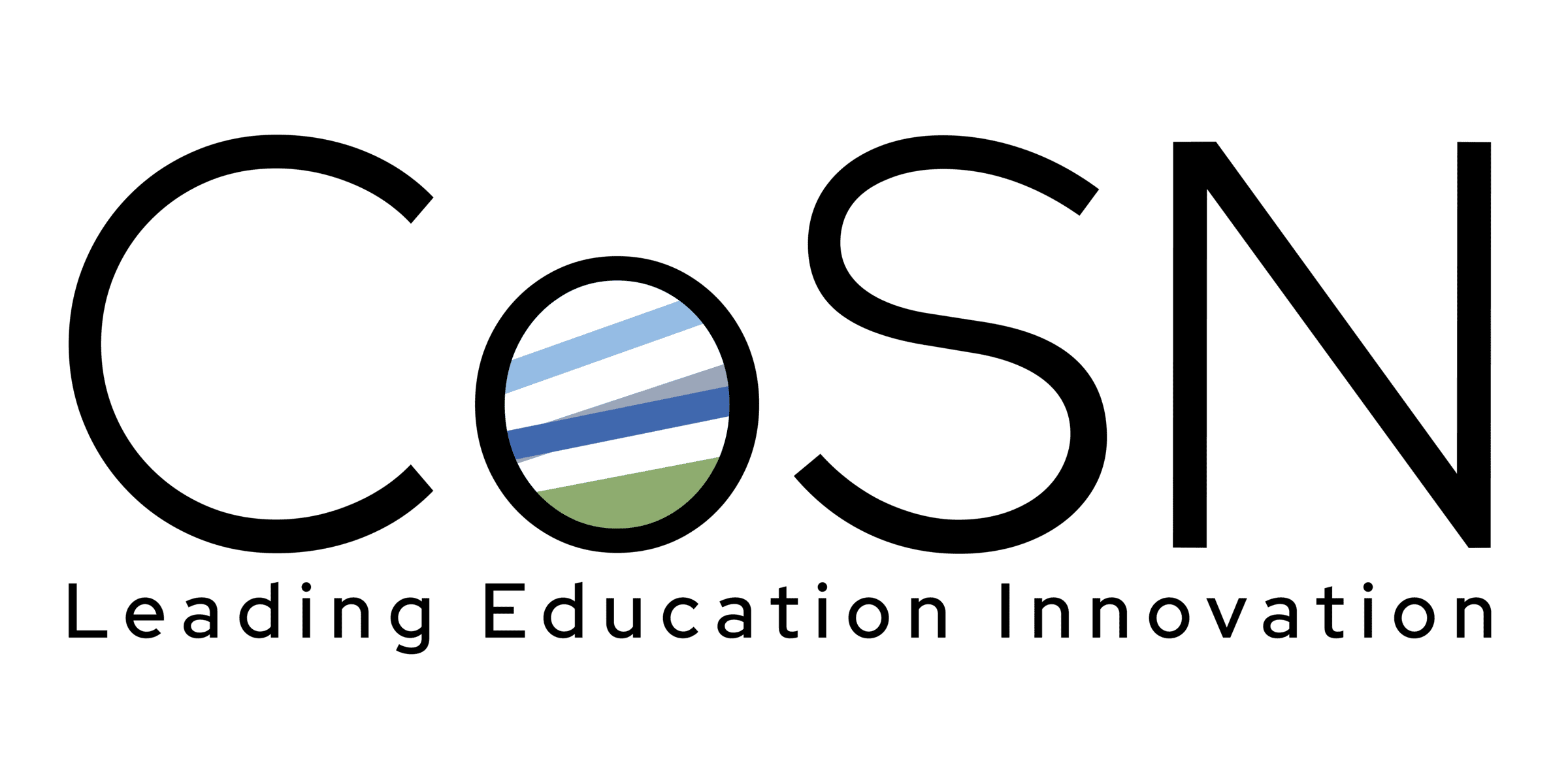Key Findings Highlight Expanding Role of EdTech Leaders Amid Rising AI, Cybersecurity and Connectivity Challenges
Washington, D.C. (May 6, 2025) – CoSN today released its 2025 State of EdTech District Leadership report, offering critical insights into the evolving roles and responsibilities of K-12 EdTech leaders across the country. Now in its twelfth year, the annual survey offers important benchmarks on emerging artificial intelligence (AI) technologies and evolving cybersecurity measures. The findings also provide valuable information to education stakeholders — including superintendents, school boards and business officers — as they set priorities and make budgetary decisions.
One of the most critical findings from the report is the potentially catastrophic impact that the loss of E-Rate funding would have on the vast majority of school districts should the Supreme Court decide Universal Service/E-Rate is unconstitutional. Such a decision would cut off access to essential digital learning tools and online resources. AI, which relies on internet access supported by E-Rate, presents both opportunities to transform educational strategies for individualized instruction and learner empowerment as well as challenges — such as cyber-attacks, cyberbullying and misinformation. On the operational side, the rise of the Internet of Things (IoT) continues to expand the responsibilities of EdTech leaders. Managing the complexities of modernized infrastructure, safeguarding student data privacy and integrating technological innovations have given EdTech leaders a uniquely comprehensive perspective on the K-12 digital ecosystem.
“This year’s survey reveals a defining moment for K-12 education,” said Keith Krueger, CEO, CoSN. “Digital infrastructure is now the backbone of teaching, learning and school operations — and EdTech leaders are the architects holding it all together. District leaders and policymakers must act now to sustain the infrastructure and talent that keep learning accessible for all, secure and future ready.”
The 2025 survey and report were conducted in partnership with AASA, The School Superintendents Association, CDW Education, Lightspeed Systems, MCH Strategic Data and Sogolytics. This year’s top findings include:
Digital Connectivity: If the Supreme Court rules the E-Rate program’s structure is unconstitutional, the impact will be major or catastrophic for 74% of districts, affecting students in all settings — rural, town, suburban and urban. Nearly half of respondents in cities (48%) describe the impact to be catastrophic. Meanwhile, support for off-campus broadband access is decreasing post-pandemic, with just 66% of districts providing support — down from 74% in 2023. Alarmingly, only 7% of districts report all their students have access to adequate bandwidth at home.
- AI: An overwhelming 94% of EdTech leaders see AI as having a positive impact on education, with productivity cited as the top benefit. Generative AI (Gen AI) was ranked as the top technology priority, with 80% of respondents working in districts with Gen AI initiatives. Notably, only 1% of districts have taken the drastic measure to completely ban its use. It is more common for districts to allow or disallow AI based on use case. A majority (57%) of districts use or are exploring the use of tools to detect AI-generated answers in student work.
- Cybersecurity: Most school districts do not have dedicated funding to keep their networks and data secure, with 61% relying on general funds to pay for cybersecurity efforts. The majority (78%) invest in monitoring, detection and response tactics. Despite these concerns, EdTech leaders generally do not view their districts as high-risk. Phishing is the top threat, rated high risk by 27%, followed by data breaches and ransomware at 13% each. With current federal policy changes and funding cuts to the Multi-State Information Sharing and Analysis Center (MS-ISAC), which had provided cybersecurity training at no cost, cybersecurity risks are likely to increase.
- Interoperability: The number one barrier to improving interoperability is not the lack of agreed-upon standards — which survey respondents ranked the least problematic — but a lack of understanding by leaders. While there are procedures around the purchase of digital tools, free tools that are downloaded in an ad hoc manner put district data at risk. Increasingly, districts are adopting processes to vet free tools before they are integrated into their digital ecosystems. The most significant improvements are the practices for an “approved” apps list now used by 59%, compared to 42% in 2023.
- EdTech Leaders: While the overall demographics of EdTech leadership remain largely consistent, there was a notable shift in gender representation, with female respondents dropping to 29%, down from 37% in 2024. Another trend is the shift in professional backgrounds: in 2015, most EdTech leaders came from education backgrounds (58%), while in 2025, the majority came from technology backgrounds (52%). This shift may reflect the role’s growing focus on infrastructure, cybersecurity and systems integration. Age data also reveals a generational divide, with 61% of female respondents aged 50 or older compared to 52% of male respondents under 50.
“The nation’s education technology leaders are managing more than ever — overseeing everything from HVAC systems and internet connectivity to cybersecurity and real-time bus tracking. It’s crucial for these leaders to have a seat at the table during district leadership conversations. The future of education depends on coordinated, well-resourced digital ecosystems, and this report demonstrates that we cannot allow policy or funding gaps to undermine the infrastructure that supports student learning,” said Dr. David R. Schuler, Executive Director, AASA, The School Superintendents Association.
“CDW values our partnership with CoSN to support our K–12 districts. The annual State of EdTech District Leadership survey advises us on how to support our district leaders to solve problems, plan for the future and build capacity in education technology leaders,” said Janice Mertes, State Level Ambassador, CDW Education.
“AI and other emerging technologies bring both promise and complexity, and Lightspeed is committed to helping districts navigate these advancements safely and effectively. We’re proud to sponsor CoSN’s State of EdTech District Leadership report — a crucial pulse-check that helps us all move forward and better serve students,” said Amy Bennett, Chief of Staff, Lightspeed Systems.
The findings of this report help inform CoSN’s resources and programs, ensuring that its offerings are aligned with the real-world challenges and priorities of EdTech leaders across the country. By understanding districts’ evolving needs, CoSN continues to provide the professional development, advocacy and support needed to build engaging, secure and future-ready learning environments.
To download the full report, visit: https://www.cosn.org/tools-and-resources/resource/2025-state-of-edtech-district-leadership/.
To learn more, visit: https://www.cosn.org/edtech-topics/state-of-edtech-leadership/.
About CoSN
CoSN, the world-class professional association for K-12 EdTech leaders, stands at the forefront of education innovation. We are driven by a mission to equip current and aspiring K-12 education technology leaders, their teams, and school districts with the community, knowledge, and professional development they need to cultivate engaging learning environments. Our vision is rooted in a future where every learner reaches their unique potential, guided by our community. CoSN represents over 13 million students and continues to grow as a powerful and influential voice in K-12 education. www.cosn.org/
AASA, The School Superintendents Association
AASA, The School Superintendents Association, founded in 1865, is the professional organization for more than 10,000 educational leaders in the United States and throughout the world. AASA’s mission is to support and develop effective school system leaders who are dedicated to equitable access for all students to the highest-quality public education. For more information, visit www.aasa.org.
CDW Education
CDW Education makes technology work so students can do great things. We are a trusted partner to schools, districts, and institutions of all sizes. CDW Education leverages a unique combination of decades of boots-on-the-ground education experience and best-in-class partners, solutions, and services to help you drive the education outcomes that are most important to you. www.cdw.com/
Lightspeed Systems
With more than 25 years of serving education, Lightspeed Systems delivers the most in-depth visibility and control to power exceptional schools where students are safe and engaged; technology is compliant and easily managed; and resources are secure and optimized. Purpose-built for schools, Lightspeed’s cloud-managed solutions include the most effective web filtering, student safety monitoring, analytics, classroom management, and device management software available. Headquartered in Austin, Texas, Lightspeed serves over 23 million students across 31,000 schools in 43 countries, utilizing 15 million devices. www.lightspeedsystems.com/
MCH Strategic Data
MCH Strategic Data is a pioneer and innovator in educational marketing data. For nearly a century MCH has helped businesses reach administrators and educators within school districts nationwide and of all sizes. Trusted by the CDC, National Institutes of Health, and Harvard to provide the most up-to-date school district data during the pandemic, they offer national data coverage, invaluable expert insights, and top-tier personal service to help clients reach their customers with pinpoint accuracy. www.mchdata.com/
Sogolytics
Sogolytics helps organizations transform feedback into action through an easy-to-use experience management platform that unites powerful survey tools, managed research, automated analytics, and real-time reporting. Whether measuring customer satisfaction, employee engagement, or market sentiments, Sogolytics simplifies data collection and turns insights into impact. With customizable solutions, enterprise-grade security, and expert support, organizations of all sizes can make smarter decisions, improve performance, and build stronger partnerships. From credit unions to K12 institutions, Sogolytics makes it easy to listen deeply, respond effectively, and drive meaningful change. www.sogolytics.com/
MEDIA CONTACT: Grace Helsing, ghelsing@fratelli.com

